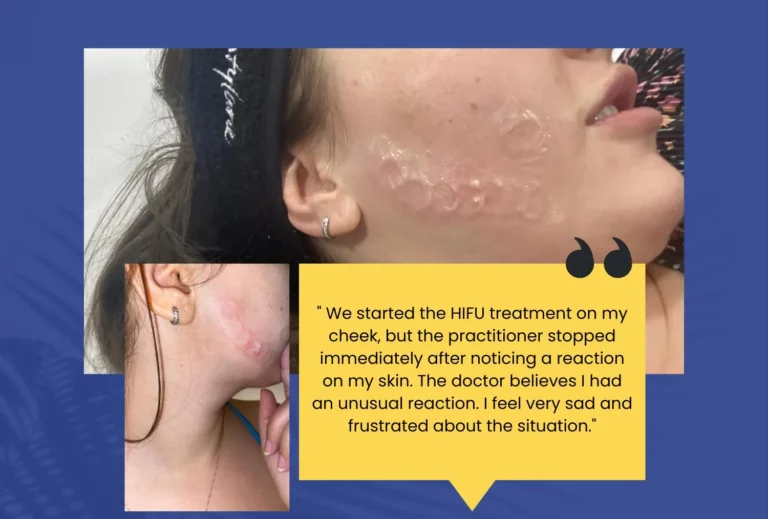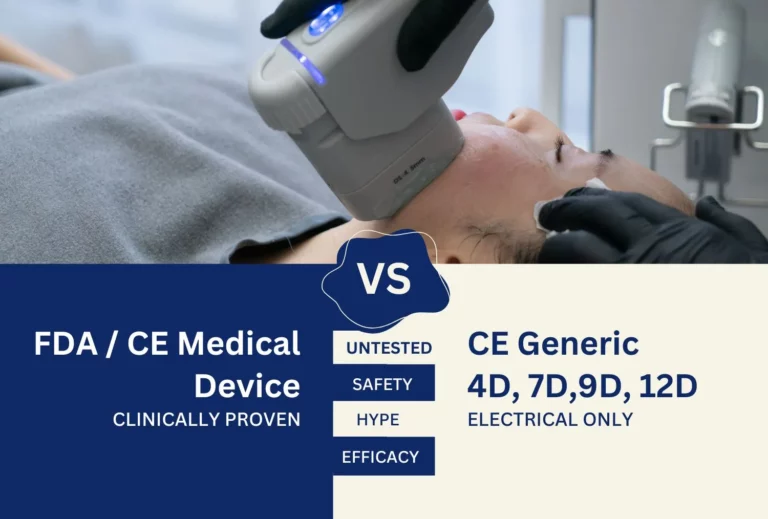I. Why is the topic important?
In recent years, cosmetic HIFU (High Intensity Focused Ultrasound) therapy has become a preferred non-invasive alternative for skin tightening and rejuvenation. Many beauty salons and studios present it as a “reasonable” or “risk-free” alternative to more invasive methods, including injectable treatments with hyaluronic acid, botulinum toxin, or even surgical facelifts.
These claims sound strong, but do they create realistic expectations for clients? Can HIFU really provide similar results, or does the comparison underestimate the differences in mechanisms and depth of effect?
The purpose of this article is to objectively examine the facts:
- What results can we realistically expect from HIFU therapy?
- Where does it overlap with the effects of injection and surgical methods?
- And when is one option more suitable than the other?
It is time for informed choices, based not on fear, but on understanding.
II. What distinguishes HIFU therapy from other methods?
HIFU (High-Intensity Focused Ultrasound) is a non-invasive technology that uses focused ultrasound waves to create controlled heat in the deep layers of the skin, most often at the SMAS level (the same layer treated in a surgical facelift). This stimulates the natural regeneration process, including neocollagenesis (synthesis of new collagen), resulting in gradual tightening and lifting of the skin.
Main difference compared to other methods:
- Injection procedures Botox and fillers have a completely different mechanism. Botulinum toxin temporarily "turns off" the muscles that cause facial wrinkles, while fillers physically fill in volumes or correct contours, with the effect visible almost immediately.
- The surgical facelift offers a lasting and visible result by removing excess skin and reconstructing tissues, but is associated with a recovery period, operational risks, and a high cost.
HIFU does not directly replace these procedures, it cannot restore lost volume or relax overly tense muscles. The method can improve the overall tone and firmness of the skin, especially in the initial stages of aging.
HIFU therapy is suitable for people looking for a moderate and natural improvement without resorting to needles or a scalpel, but it is not an equivalent to injectable or surgical methods. Rather, the method is a complement or alternative for a certain stage of the aging process.
III. What are the limitations of HIFU procedures?
Although HIFU is often presented as the "reasonable alternative" to facelift surgery or injection therapies, it has its limitations and it is important to know them in order to build realistic expectations.
Limitations of The HIFU procedure:
- Not suitable for advanced signs of relaxation: In cases of severe sagging skin or pronounced wrinkles, the effect of HIFU is limited. In such cases, a surgical lift or a combination of invasive methods may provide more tangible results.
- No effect on lost volume: HIFU cannot restore volume in the face (for example, in the cheeks or around the lips), which is the effect that fillers achieve.
- The results are developing slowly: Unlike injection therapies, where the effect is visible almost immediately, HIFU requires patience - results are built over time.
- Does not guarantee results for everyone: The response to HIFU exposure in some people may be weaker, especially with very thin skin, advanced age, or severely damaged collagen matrix.
Comparison with invasive methods:
| Criterion | HIFU | Injections/operations |
|---|---|---|
| Procedure type | Non-invasive | Minimally Invasive/Invasive |
| Recovery period | Almost none | From a few days to weeks |
| Time to effect | Gradually (weeks–months) | Immediately or within 2 weeks |
| Duration of effect | 6–12 months | 6–24 months (fillers); years (surgery) |
| Change in appearance | Fine and natural | More visible and targeted |
IV. In which cases is HIFU really a good alternative and when is it not enough?
HIFU is suitable when:
- There are mild to moderate signs of skin saggingThe best results are achieved in people between the ages of 30 and 50 with relatively good skin condition.
- You want a non-invasive procedure with no recovery period.
- Aim for a more natural result, without change in facial expression or volume.
- You wish to postpone a more invasive interventionHIFU can extend the time until fillers, Botox or facelifts are applied.
The HIFU procedure can be an excellent choice in anti-aging care for certain types of clients, but it is not a universal solution. Understanding when to be used and when It is better to apply another approach is key to safety, effectiveness and satisfaction with the result.
HIFU is not sufficient when:
- There is pronounced sagging, especially in the lower face or neck.
- There is loss of volume and pronounced sagging.that require fillers or lipofilling.
- You are looking for a quick and dramatic effect. With HIFU, the effect develops slowly and is more subtle.
- The skin is severely damaged (for example, after heavy sun exposure or smoking) In such cases, the collagen response is weak and the result may be unsatisfactory.
V. The difference between “non-invasive”, “alternative” and “equivalent”
In the world of aesthetic medicine, the terms "non-invasive", "alternative" and "equivalent" are used loosely, sometimes even misleadingly. However, it is important for consumers to understand the real meaning behind each word, especially when making a choice between procedures like HIFU and injectable or surgical methods.
Non-invasive procedure means that the process does not penetrate the skin – there are no needles, incisions, anesthesia or recovery period. This is true for HIFU and is one of its main advantages.
Alternative It sounds like a substitute, but in an aesthetic context, it doesn't always mean the results will be comparable. HIFU can be an alternative for people who don't want injections or surgery, but that doesn't mean they will get the same or similar effect.
Equivalent however, is a term that implies equivalent result This is rarely realistic when comparing non-invasive technology to surgical facelifts or even dermal fillers.
Marketing often creates the illusion that HIFU is a direct replacement for more invasive methods. In reality, each technology has its own capabilities and limitations. Calling HIFU a “non-surgical facelift” without further clarification can create unrealistic expectations and ultimately disappointment for the client.
VI. Why “HIFU instead of surgery” claims are misleading
Increasingly, advertisements and websites of cosmetic centers contain statements such as “HIFU is an alternative to facelift surgery” or even “a substitute for plastic surgery.” Such phrases sound appealing, but they do not reflect reality and can create unrealistic expectations among clients.
HIFU cannot achieve the same results as surgery
A surgical facelift alters anatomical structures – it physically lifts the skin and underlying tissues, removes excess skin, and can dramatically alter contours. HIFU, on the other hand, stimulates collagen production by heating the deep layers of the skin, but it does not remove excess skin, does not change the location of tissues, and does not provide an "instant" result.
Misleading comparisons undermine trust
When a HIFU cosmetic procedure is presented as an “alternative to surgery” without a clear distinction, it understates the seriousness and specificity of each method. This not only misleads clients, but also damages the overall reputation of the aesthetic industry.
What can to do HIFU?
HIFU is good preventive and maintenance therapyIt is suitable for people who want to:
- to tighten the skin slightly to moderately;
- to delay the visible signs of aging;
- to postpone more drastic interventions;
- to obtain a natural result without a recovery period;
Read more: What results can we realistically expect from HIFU and how long do they last?
Conclusion: HIFU has its place in modern aesthetics, but it cannot be considered a full-fledged substitute for injection and surgical methods. It is important that clients are objectively informed so that they can make a choice based not on marketing promises, but on realistic expectations and individual needs. An honest approach and the correct presentation of the technology's capabilities are the best basis for building trust and long-term results.



